Canada Days.
In England, the habit of putting up the St. George’s cross is reserved for when England are playing in a major football tournament. While Americans have not taken to flying flags from the sides of their cars, the flag is more prominently displayed in front of houses and houses, and of course, the national anthem is played before sports events, even with the low attendance for matches such as the PDL, (indeed, at Kalamazoo, both US and Canadian anthems were played). Crossing the border to Canada, one still sees national flags that I would guess are always displayed, plus an increase as people get more patriotic as Canada Day (1 July) approaches. There are even some cars that are flying small Canadian flags, but there are just as many flying other country’s flags for the World Cup. Most popular among these is the Portuguese flag, with Germany a distant second. Indeed when I entered the country, the customs official asked if I was escaping after England’s poor performance. When I said, yes but Canada did not even come close to qualifying he replied that he was Portuguese, and would be coming off shift before they played Spain.
I wanted to keep on the road, so I drove about two hours from the customs post to the City of London before stopping an quickly finding a sports bar, watching most of the Portugal-Spain match. There were a group of rowdy Portuguese supporters in the bar, and a smaller (and quieter) number supporting Spain. The early game I did not see live, but saw a replayed evening transmission when I stopped for a meal. Still, ,most of the afternoon and early evening was spent on Highway 401 which runs from Windsor (connected to Detroit by toll bridge) up the north side of one of the lakes and up to Montreal. The only traffic problems I encountered were around Toronto. The odd thing about the Canadian motorway is that I spent my first two hours on a fairly quiet road, but the traffic kept in the main to just a smidgen over the speed limits. As I approached Toronto, the traffic became busier, but the speeds became faster. My theory is that on the open road, it is relatively easy for the police to pick on a speeding motorist, but there is safety in numbers, so cars feel safer to go fast in a group, knowing the police cannot stop them all. Safety is of course a relative term, as tiredness and boredom is more likely to set in while driving slowly (well 70 mph, the speed limit is 100 km/h, or 62 mph) on an open road, while one needs to concentrate in a busier area.
I made my overnight stop about an hour’s drive beyond Toronto, with a meal and a beer first, so it was late when I settled down. In the morning, I was not quick starting and then took some time to drive off the motorway. The motorways are full of traffic, but coming off the main road does not help to explain where everyone is going to. The secondary roads are remarkably quiet not many people take the alternative, and the road itself is slightly disappointing. Despite running parallel to the edge of the lake, and the St. Lawrence river, there are few scenic opportunities to stop and admire. Some of the small towns have marinas, full of pleasure craft, but the river, when you get to spot it is clear of traffic. The towns are all of a muchness, pleasant enough places with small malls and plenty of parking. Not many people around though. As you drive in and out of these towns, most of the housing is wooden fronted, standing well back from the road with a perfectly manicured lawn in front (no fences at all Canada is not part of the land of picket fences). All the lawns seem to be cut to a uniform size, leading one to wonder whether the residents cut their own, or if someone cuts the entire lot in a broad sweep. If everyone cuts deals with their own, then the question is who inspects the mowers, to make sure all the grass is the same length, and is there a National grass cutting day to make sure it is all cut at the same time. Oddly, considering the schools are out and it is a holiday weekend, there were no children on these lawns – in fact, there were no people on the lawns at all. I do not feel I would make a good Canadian, with my unkempt garden wilderness lying untended back home.
Shortly before arriving at Montreal, one crosses from Ontario to Quebec province. The road number changes, the quality of road surface deteriorates badly, and when you stop, people speak to you in French first. Often they keep on speaking French even after you have spoken in English. As in France, I just ignore them unless I am trying to pick up some information. The French speakers, (whether in France or Montreal) seem to stick to the same policy, jabbering away even when it is clear they are not being understood. They do not even take on the English habit of speaking slowly and loudly to get the message across.
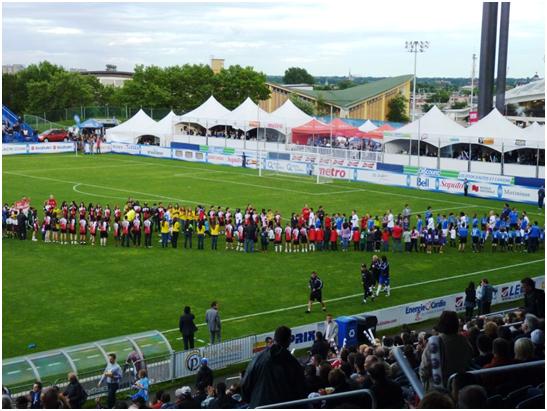
Montreal is an interesting city, with a contrast between the older parts (which of course are not much over a century old) and modern buildings. The older buildings sit like slabs of stone, with ostentatious touches. The new buildings, like any modern city are a mixture of the mundane, and those trying to stand out. If you venture away from the main road, the backs of the buildings are the domain of graffiti artists with fire escapes hanging in the air, and large waste containers huddled against the walls, waiting for the garbage trucks. In the end, it was disappointing that I had not allowed more time here, (I was over an hour later than I planned in arriving anyway, having spent longer on side roads, and then the traffic into the town being difficult). Naturally, the only rain storm so far on the trip came as I tried to explore a small central area of the city.
The Saputo Stadium is on the Olympic Park, next to the Olympic Stadium. Montreal staged the Olympics in 1976, but the stadium was only completed in 1987. It now stages Baseball, American Football and the occasional soccer game, (AC Milan have played there recently), but with a 76,000 capacity, it is still considered a white elephant. The stadium is known either as the big O, referring to its doughnut shape, or the big owe, referring to the bills that the city have only just paid off for its construction. By comparison, the Saputo stadium is a modest affair. Behind one goal and all along one side, there are large banks of seating, built up on a steel and aluminium construction and without a roof. The main stand is slightly lower, with more concrete in the construction and a roof that will protect the crowd if the wind and rain is from the North, but not from Southerly storms. Unusually, the main stand is the Northern side of the stadium. At the back of this stand, there are a number of boxes, some given over to media, the others for sponsors. There are a number of other areas reserved for those people who have either paid a premium for the tickets, or got them from free from a company paying for the hospitality. Behind one goal, there is no stand, but a series of small marquees, and at both ends of the main stand there were terraces with people eating and drinking in restaurant fashion. The tables had individual seats, and bar umbrellas. The pitch was 3G artificial, and played well. The bounce was normal, there were no clouds of the black dust seen on some artificial pitches, and the ball did not speed away to the sidelines.
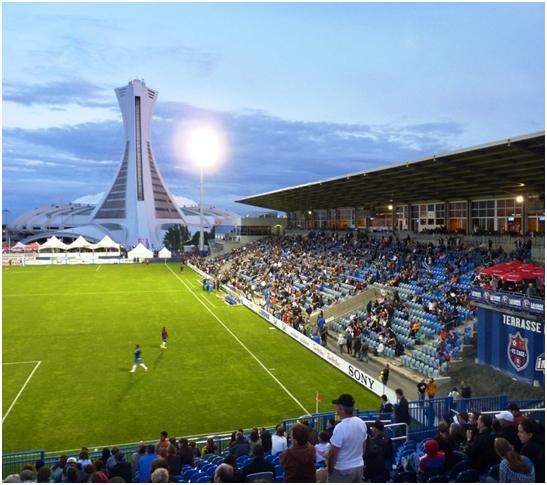
The crowd for the match was just shy of 12,000. How much of the much some of them saw was uncertain. Despite the match being advertised as 7.30, and actually kicking off at 7.47, people were still swarming around the entrances for at least 20 minutes after the game started, and the last paying customers did not arrive until near enough half time. Meanwhile, the path at the front of the stand was a constant highway, with people heading back and forth to the concessions in the corners of the stadium. Ticket prices were generally from C$20 up to C$50. All prices were available on the night. I had looked at the on-line sales process, and this added a total of C$10 to the price, a service fee, and C$2.50 simply for them to deliver the ticket to the stadium for collection, (the only option available if booking from outside Canada).
The name Saputo stadium comes from the club’s owner, Joe Saputo, who operates Canada’s biggest dairy products concern. I am fairly certain though that the stadium is owned and was built by the city.
This is the fourth time the teams had met this season (twice in the league, and twice in the Canadian Championship a tournament between Montreal, Vancouver and Toronto to select a contender for the CONCACAF champions league). The teams play in a 12 team, 30 match league and will meet twice more later in the season. All three previous meetings were drawn.
Montreal made a good start when in the third minute, Leonardo Dilorenzo took a free kick on the right hand side, floating it in for Tony Donatelli to head home, and in the ninth minute came close to repeating the feat, this time Byers heading wide from a free kick delivered from the left. Montreal continue to dominate the first half, and many people in the crowd thought they scored again on 30 minutes, when Byers went past the goalkeeper, but hit the ball into the side netting. Vancouver made a substitution at half time, and came out with a more attacking formation. This paid off with Vancouver now having much the better of the play, and deservedly getting level in the 66th minute, the ball being worked in with close passes from the left until it reached Janicki, who turned the defender and placed a low shot beyond the keeper. This at least woke up the home side, who had been dozing through the second period. The thought they had restored the lead when first Byers, receiving the ball from Philippe Billy forced a fine save, and then the ball was returned via Billy to Byers who crossed this time for Dilorenzo to put into the net. Unfortunately, Byers was off side when he received the ball for the second time. This turned out to be a rare play for Montreal in the second half as they produced little else, and it appeared the game would end in a draw, until Luca Bellimisomo turned and shot from just outside of the area in the first minute of injury time, and gave Vancouver a surprise win. On the first half performance, Montreal should not have lost this game, but they only managed a single goal in this period, and never really competed after the break.
More than five hours of driving from Montreal to Toronto, I did around two hours after the game, not returning to my motel until well after midnight. Thursday was Canada day, and clearly the real start of the holiday weekend. Most of the traffic, though seemed to be heading out of Toronto, and I had a clear run, while there were many jams heading east. Still, when I arrived in the city, it was lively. I found the old city, and was pleasantly surprised to discover that the “flatiron” building had a pub in the basement immediately flagged for a visit after the game. Even busier was the lake front area with more time, it might have been possible to walk all the way to the stadium, but time was limited, and my feet were already blistered, so it was the tram for me.
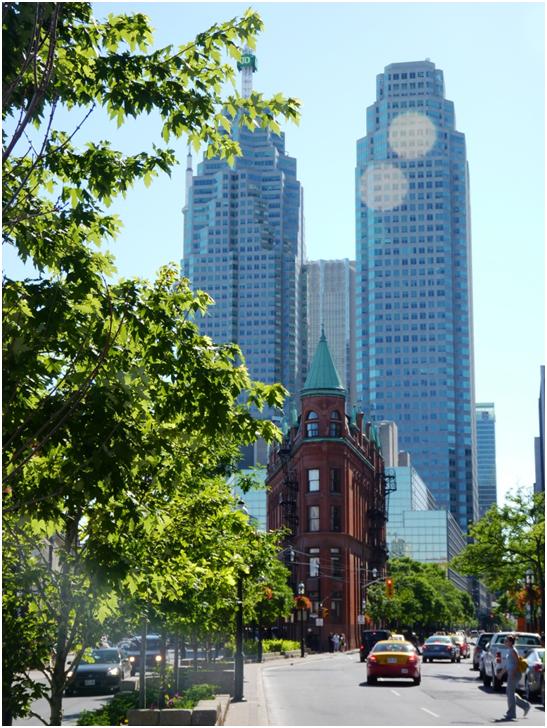
Toronto has a spectacular skyline, and it may just be that the best view can be had from the upper tier of seats at BMO Field. The stadium is what is known in Canada and the USA as Soccer Specific, that is to say, it was designed with the soccer team in mind, rather than being original used for another sport, or a multi-purpose arena. The four sides are therefore square to the pitch. Three of the four sides are open, and the roof of the main stand is small and high. The stand itself is a very tall affair, arranged in two tiers with a row of executive boxes in between. These boxes extend around to provide the only section where the corners are filled in, but it is not all executive boxes. A small open air terrace near one end box was given to a small steel band, who drummed continuously through the game. While the upper tier has the views, it also has a very steep rake. On the east side, there is a fairly big affair, some 40 rows of seats in a single tier, while behind the south goal the stand rises only about half as high. These three stands are all concrete, with one corner reserved for the “singing section”. Almost all the fans on the south side stand up, even though they all have seats. The north side is somewhat different, with just about four or five rows of concrete. Raised quite high above this for about half the width (central) is a steel and aluminium stand of around 25 rows. The main scoreboard sits above this stand. Each side of it, are low buildings, which I assume are concessions or VIP sections. The one nearer to me had bar type tables outside, whereas the other had quite a few people standing outside. Screens above these showed the match on a relatively small screen, with advertising on a much bigger area.
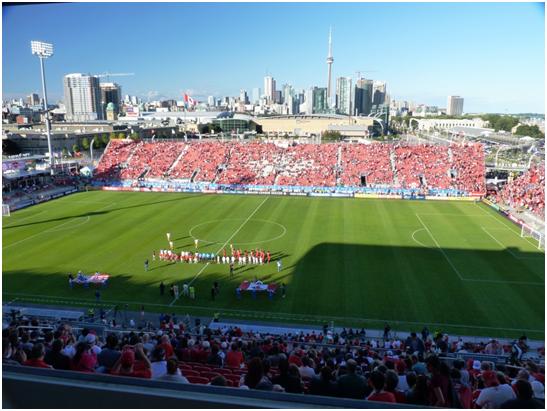
Both teams lined up in 4-4-2 formation, and both created an early chance but then the game settled down with neither side having a creative edge, and generally losing the ball with long wild passes. In the 21st minute, a Toronto long pass found its target forward Chad Barrett but he lost the ball when trying to cut inside a defender. It was another 13 minutes before we saw another attempt at goal, this time Dwayne de Rosario, one of the Canadians on view turned and shot over from around 25 yards. Three minutes before the break, we had a move worthy of mentioning, with a short cross cut in by De Rosario, from which Jacob Petersen hit the ball into the side netting. Toronto created another chance just from an injury time free kick. Those last few minutes indicating they might just have an edge. It was, however, the visitors from Houston that made most impression early in the second half, enjoying possession, but not creating much. Brain Mullen put the ball in the net for them on 57 minutes, but he was clearly offside, and the linesman was quick to rule it out. The crowd finally got something to shout about on 62 minutes, when Joseph Ngwenya squared up to several home players, and then almost everyone else ran in to join the melee, Ngwenya and home player de Guzman were both sent off, while another Toronto player Nana Attakora was cautioned. At least after this, the home side started to play football again, forcing a corner from which Barett shot high over the bar. In the 73rd minute, Houston broke the deadlock when Brian Ching beat his marker and headed in from a corner. It was almost two within a minute when Lovel Palmer’s shot was saved by the home keeper. Toronto managed a series of attacks, firstly substitute Faud Ibrahim crossed from the left, but into a sea of defenders, one of whom knocked it out for a corner. The corner was cleared, but de Rosario picked up the loose ball, beat a defender and shot from 20 yards, resulting in a fine save from the Houston goalkeeper. Then from this corner the ball was hit deep beyond the far post, where it was met by a firm header by Dan Gargan to level the scores, and finally give the home fans something real to cheer. By and large the fans were still hear as well as unlike the previous night, there was no large scale exodus nearing the end. Still, all Toronto managed after the equaliser was a series of tame long balls that were as easily defended as those earlier in the game, and a raising of temperatures in the area in injury time, resulting in Toronto’s Amadou Sanyang receiving his second yellow card, and Toronto playing the last 25 seconds with just nine men.
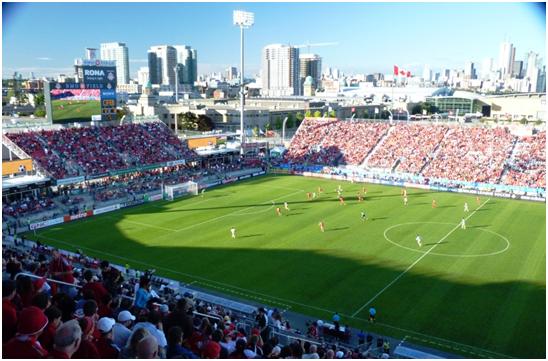
Toronto are Canada’s premier football club, but when I looked through the squad lists for the match, I could only identify 7 players of the 36, (6 of the 22 starters) that were listed as born in Canada. I viewed this as not good for football in Canada, but when I asked the local journalists, they found the figure to be encouragingly good, while I thought it was disappointingly poor. Toronto also run an Academy team in the Canadian Soccer League, and their team in that is almost exclusively Canadian but as I would discover later, the class difference is such that that it will be hard for players to step up.
With a crowd given as over 21,000, there were not many seats available. However, the ticket office was open and it was possible to buy. Still, there were plenty of scalpers in action outside the stadium. I did not go as far as finding out whether they were charging a premium for the tickets, and how much over the top prices went. I am told the Toronto FC have sold 16,000 season tickets, a clear demonstration of the current state of the MLS, and particularly some of the newer franchises. Looking around, two things were noticeable about the crowd, especially when comparing to the situation back home in Britain. Firstly, the mix in the crowd a city like Toronto is extremely cosmopolitan, and yet I saw no signs of racial tension or of ghetto areas. I may have been lucky in this respect, of course. The crowd at the football was also very cosmopolitan, and this must be an advantage to the club over the situation in Britain, where football clubs fail to appeal to racial minorities. The second factor about the crowd was at appeared to have a young average age. I have heard many comments suggesting that the average age of spectators in England is increasing, and more worryingly, the numbers of new young supporters are diminishing. Toronto is a new young franchise, and appears to have an audience to match. The crowd was in god voice, raising their scarves high when the national anthem was sung at the start of the game (and it was sung, the public address just played the first few bars, and then stopped, leaving the crowd to voice the words unaided).
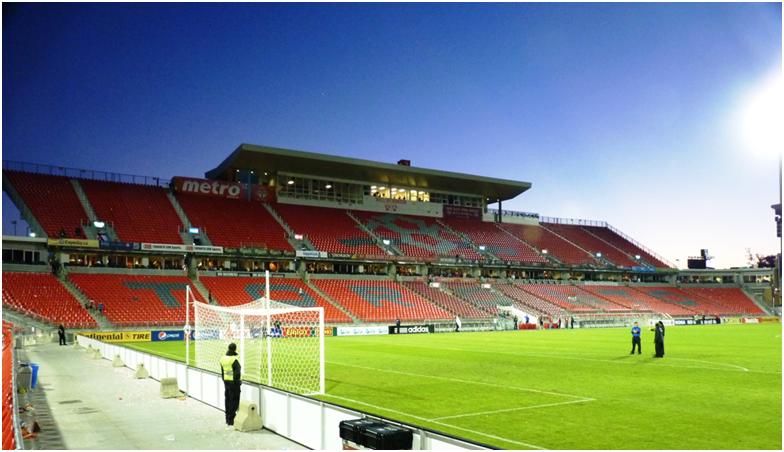
A couple of post match notes quite a few fans hang around after the match. I came across a small group, dancing what I first thought was one of the steel drums, but actually turned out to be a rubbish bin. Still they got a good drumbeat going. When I pointed out this was a drawn match, and ask how they celebrated a win, the answer was “you don’t want to know”. A portion of the crowd were stopping to see a firework display for Canada day, – and yet still an hour after the match finished, there were long and slow queues of cars leaving the parking area. I checked out the stall selling replica shirts, they were selling at C$129.99 just under £90!! And most prices in Canada are quoted without tax, so there may be another 13% on top of this.

And so onto my last day in Canada which started with a visit to Niagara Falls. The Falls themselves are as spectacular as may be expected, and are well worth a visit, but the rest of the town is a series of tacky tourist attractions, that I just found unattractive. I am told it is worse on the USA side of the border, but I was not crossing to find out. After the match, I made my way back towards the USA, stopping in London. London has two teams, Forest City London, who won the PDL match at Kalamazoo which started my tour, and London City, playing in the Canadian Soccer League. This is the top football league within Canada, although by and large it is restricted to the state of Ontario. Both Montreal and Toronto operate reserve teams in the league, but Trois-Rivieres Attak who are still deeper into Quebec province are taking a year out, despite being defending champions.

London City play at the Cove Road Field, which is part of the German-Canadian club in the city. The venue is basic, around most of the playing area you can watch while leaning on a fence, and standing on grass. There are three small seated areas on the entrance side, each with about six rows of wooden seating on a steel framework. Most of the crowd, which I estimated around 150 used the seats. One of the three sections was claimed by about 20 visiting fans, who were singing and making a racket through the game. The admission price was C$10, around £7, while a free programme came in two parts. A season programme, of A5 size running to 24 pages mainly advertising but including a club history. In addition a single A4 sheet (printed on the same glossy paper as the programme)gave the two squad lists for the match.
The match took some time to get going plenty of enterprise in early exchanges, but most were easily defended. The match turned on the opening goal, which are scored by the visitors, North York Astros in the 35th minute. Mahyar Kohbad, received the ball near the edge of the area, and hit a powerful shot into the top corner. From this point, it always appeared that the Astros were going to win the game, especially as London’s chances, and they had a few, were somewhat softly wasted. Kohbad added the second goal from the penalty spot in the 52nd minute, and a third goal was added with 10 minutes to play.
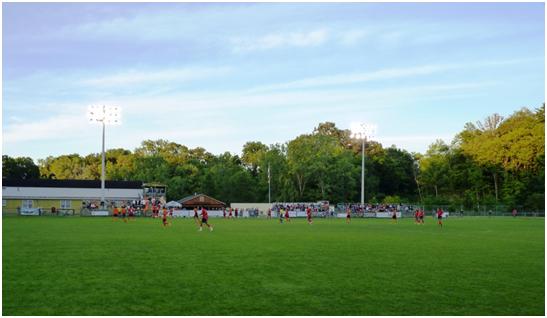
Where does this leave Canadian football. I think it has a problem. The big three are doing well enough, and it can only improve things when all three are in the MLS. There clearly is demand for good quality football when it can be provided. But there is nothing at all between the top three clubs and those who are in either the Canadian Soccer League or the PDL so great parts of the country are left out. The quality of the Canadian Soccer League is quite poor, it is not capable of grooming players who are going to compete at an international level. It may work as an academy level for Toronto and Montreal, but not as a reserve league. The only person I saw that could make the change in grades was Geoff Gamble, who refereed the game for London City, and was also the fourth official the previous day at Toronto.
Comments are closed.